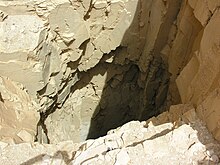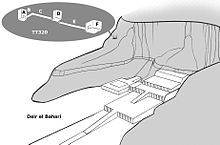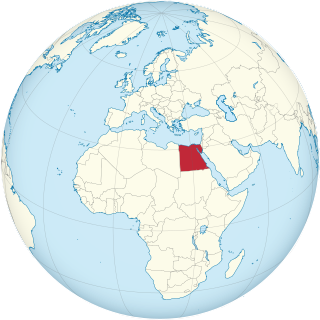
Articles related to Egypt include:

Neferkare Setepenre Ramesses IX was the eighth pharaoh of the Twentieth Dynasty of Egypt. He was the third longest serving king of this Dynasty after Ramesses III and Ramesses XI. He is now believed to have assumed the throne on I Akhet day 21 based on evidence presented by Jürgen von Beckerath in a 1984 GM article. According to the latest archaeological information, Ramesses IX died in Regnal Year 19 I Peret day 27 of his reign. Therefore, he enjoyed a reign of 18 years, 4 months and 6 days. His throne name, Neferkare Setepenre, means "Beautiful Is The Soul of Re, Chosen of Re." Ramesses IX is believed to be the son of Mentuherkhepeshef, a son of Ramesses III, since Mentuherkhopshef's wife, the lady Takhat bears the prominent title of King's Mother on the walls of tomb KV10, which she usurped and reused in the late 20th Dynasty; no other 20th Dynasty king is known to have had a mother with this name. Ramesses IX was, therefore, probably a grandson of Ramesses III.

Deir el-Bahari or Dayr al-Bahri is a complex of mortuary temples and tombs located on the west bank of the Nile, opposite the city of Luxor, Egypt. This is a part of the Theban Necropolis.

Menkheperre, son of Pinedjem I by wife Duathathor-Henuttawy, was the High Priest of Amun at Thebes in ancient Egypt from 1045 BC to 992 BC and de facto ruler of the south of the country.
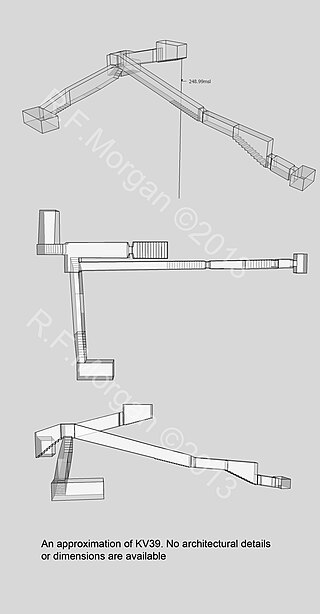
Tomb KV39 in Egypt's Valley of the Kings is one of the possible locations of the tomb of Pharaoh Amenhotep I. It is located high in the cliffs, away from the main valley bottom and other royal burials. It is in a small wadi that runs from the east side of Al-Qurn, directly under the ridge where the workmen's village of Deir el-Medina lies. The layout of the tomb is unique. It has two axes, one east and one south. Its construction seems to have occurred in three phases. It began as a simple straight axis tomb that never continued past the first room. In the subsequent phase, a series of long descending corridors and steps were cut to the east and south. It was discovered around 1900 by either Victor Loret or Macarious and Andraos but was not fully examined. It was excavated between 1989 and 1994 by John Rose and was further examined in 2002 by Ian Buckley. Based on the tomb's architecture and pottery found, it was likely cut in the early Eighteenth Dynasty, possibly for a queen. Fragmentary remains of burials were recovered from parts of the tomb but who they belong to is unknown. KV39's location may fit the description of the tomb of Amenhotep I given in the Abbott Papyrus but this is the subject of debate.

Djedptahiufankh served as Second Prophet of Amun and Third Prophet of Amun during the reign of Shoshenq I of the 22nd Dynasty.

The Valley of the Kings, also known as the Valley of the Gates of the Kings, is an area in Egypt where, for a period of nearly 500 years from the Eighteenth Dynasty to the Twentieth Dynasty, rock-cut tombs were excavated for pharaohs and powerful nobles under the New Kingdom of ancient Egypt.

Ahmose-Meritamun was a Queen of Egypt during the early Eighteenth Dynasty. She was both the older sister and the wife of Pharaoh Amenhotep I. She died fairly young and was buried in tomb TT358 in Deir el-Bahari.

Masaharta or Masaherta was the High Priest of Amun at Thebes between 1054 and 1045 BC.

Pinedjem II was a High Priest of Amun at Thebes in Ancient Egypt from 990 BC to 969 BC and was the de facto ruler of the south of the country. He was married to his full sister Isetemkheb D (both children of Menkheperre, the High Priest of Amun at Thebes, by Isetemkheb III, hence both nephew, niece and grandchildren of Psusennes I and also to his niece Nesikhons, the daughter of his brother Smendes II. He succeeded Smendes II, who had a short rule.

Ahmose-Henuttamehu was a princess and queen of the late 17th-early 18th dynasties of Egypt.
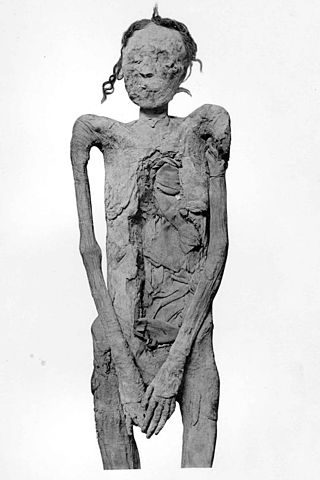
Ahmose-Sitkamose, sometimes appearing as simply Sitkamose was a princess during the late 17th-early 18th Dynasties of Egypt.
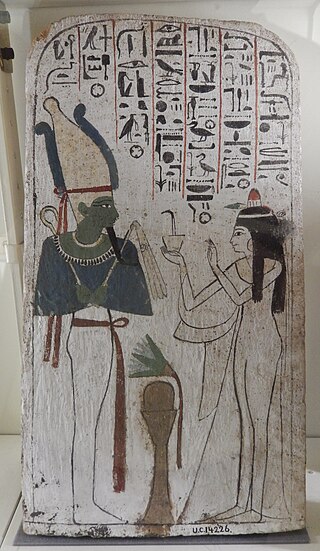
Neskhons, once more commonly known as “Nsikhonsou”, was a noble lady of the 21st Dynasty of Egypt.

Duathathor-Henuttawy, Henuttawy or Henttawy("Adorer of Hathor; Mistress of the Two Lands") was an ancient Egyptian princess and later queen.

Nauny or Nany was an ancient Egyptian princess during the Twenty-first Dynasty, probably a daughter of High Priest, later Pharaoh Pinedjem I. The name of her mother, Tentnabekhenu is known only from Nauny's funerary papyrus.

Isetemkheb D was the sister-wife of the Theban High Priest of Amun Pinedjem II during the Twenty-first Dynasty of Egypt.

The Twentieth Dynasty of Egypt is the third and last dynasty of the Ancient Egyptian New Kingdom period, lasting from 1189 BC to 1077 BC. The 19th and 20th Dynasties furthermore together constitute an era known as the Ramesside period. This dynasty is generally considered to be the start of the decline of Ancient Egypt.
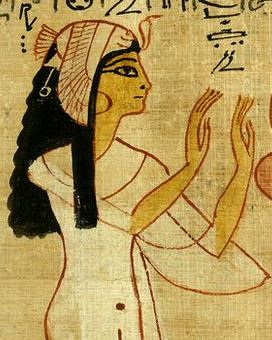
Nodjmet, Nedjmet, or Notmit was an ancient Egyptian noblewoman of the late 20th-early 21st dynasties of Egypt, mainly known for being the wife of High Priest of Amun at Thebes, Herihor.
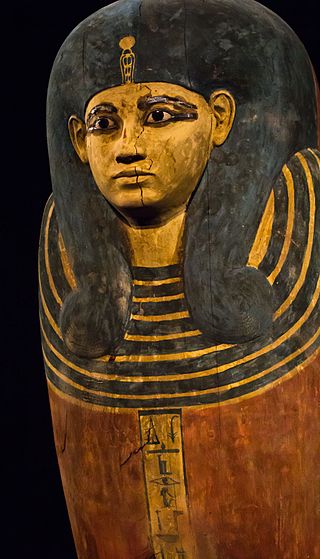
The Theban Tomb TT358 is located in Deir el-Bahari, part of the Theban Necropolis, on the west bank of the Nile, opposite to Luxor. The tomb belongs to the king's wife Ahmose-Meritamun, the sister and the wife of Pharaoh Amenhotep I. The tomb was later used for the additional burial of the King's daughter Nany, who was a daughter of Pharaoh Pinedjem I.

Bab el-Gasus, also known as the Priestly Cache and the Second Cache, was a cache of ancient 21st dynasty Egyptian mummies found at Deir el-Bahari in 1891. It was excavated by French Egyptologists Eugène Grebaut and Georges Daressy, with Urbain Bouriant and Ahmed Kamal, on the direction of Mohamed Ahmed Abd al‑Rassul, who had also revealed the location of the Royal Cache in 1881. The tomb entrance was located on the flat area just outside the precinct wall in front of the Mortuary Temple of Hatshepsut. The find was significant for Egyptology, particularly in respect of religion, mummification, and coffin studies. It is the largest intact tomb ever found in Egypt. Today, the contents of the tomb are spread between 30 museums worldwide.


